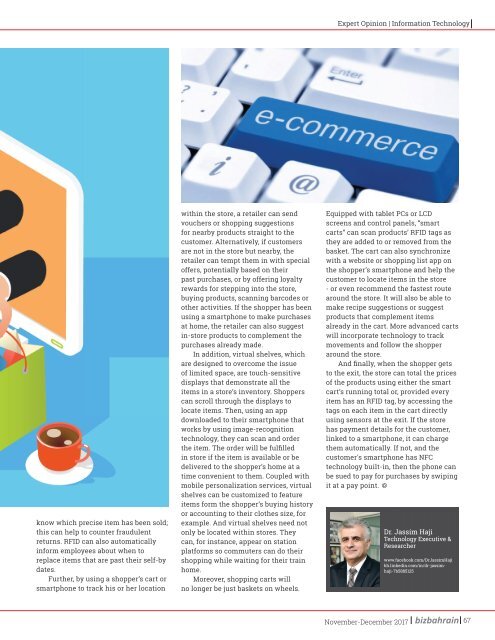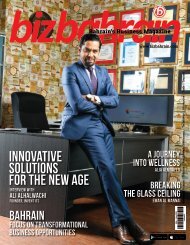BizBahrain Magazine Nov-Dec 2017
Create successful ePaper yourself
Turn your PDF publications into a flip-book with our unique Google optimized e-Paper software.
Expert Opinion | Information Technology<br />
know which precise item has been sold;<br />
this can help to counter fraudulent<br />
returns. RFID can also automatically<br />
inform employees about when to<br />
replace items that are past their self-by<br />
dates.<br />
Further, by using a shopper’s cart or<br />
smartphone to track his or her location<br />
within the store, a retailer can send<br />
vouchers or shopping suggestions<br />
for nearby products straight to the<br />
customer. Alternatively, if customers<br />
are not in the store but nearby, the<br />
retailer can tempt them in with special<br />
offers, potentially based on their<br />
past purchases, or by offering loyalty<br />
rewards for stepping into the store,<br />
buying products, scanning barcodes or<br />
other activities. If the shopper has been<br />
using a smartphone to make purchases<br />
at home, the retailer can also suggest<br />
in-store products to complement the<br />
purchases already made.<br />
In addition, virtual shelves, which<br />
are designed to overcome the issue<br />
of limited space, are touch-sensitive<br />
displays that demonstrate all the<br />
items in a store’s inventory. Shoppers<br />
can scroll through the displays to<br />
locate items. Then, using an app<br />
downloaded to their smartphone that<br />
works by using image-recognition<br />
technology, they can scan and order<br />
the item. The order will be fulfilled<br />
in store if the item is available or be<br />
delivered to the shopper’s home at a<br />
time convenient to them. Coupled with<br />
mobile personalization services, virtual<br />
shelves can be customized to feature<br />
items form the shopper’s buying history<br />
or accounting to their clothes size, for<br />
example. And virtual shelves need not<br />
only be located within stores. They<br />
can, for instance, appear on station<br />
platforms so commuters can do their<br />
shopping while waiting for their train<br />
home.<br />
Moreover, shopping carts will<br />
no longer be just baskets on wheels.<br />
Equipped with tablet PCs or LCD<br />
screens and control panels, “smart<br />
carts” can scan products’ RFID tags as<br />
they are added to or removed from the<br />
basket. The cart can also synchronize<br />
with a website or shopping list app on<br />
the shopper’s smartphone and help the<br />
customer to locate items in the store<br />
- or even recommend the fastest route<br />
around the store. It will also be able to<br />
make recipe suggestions or suggest<br />
products that complement items<br />
already in the cart. More advanced carts<br />
will incorporate technology to track<br />
movements and follow the shopper<br />
around the store.<br />
And finally, when the shopper gets<br />
to the exit, the store can total the prices<br />
of the products using either the smart<br />
cart’s running total or, provided every<br />
item has an RFID tag, by accessing the<br />
tags on each item in the cart directly<br />
using sensors at the exit. If the store<br />
has payment details for the customer,<br />
linked to a smartphone, it can charge<br />
them automatically. If not, and the<br />
customer's smartphone has NFC<br />
technology built-in, then the phone can<br />
be sued to pay for purchases by swiping<br />
it at a pay point.<br />
Dr. Jassim Haji<br />
Technology Executive &<br />
Researcher<br />
www.facebook.com/DrJassimHaji<br />
bh.linkedin.com/in/dr-jassimhaji-7b5885125<br />
<strong>Nov</strong>ember-<strong>Dec</strong>ember <strong>2017</strong><br />
67

















